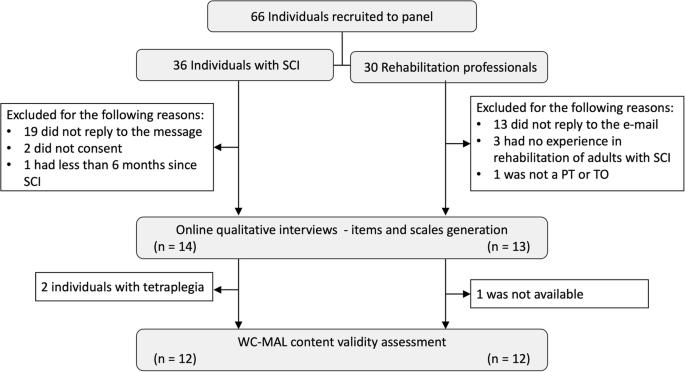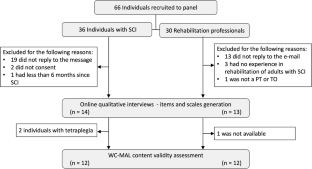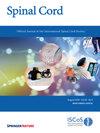通过半结构式访谈,了解脊髓损伤患者在现实生活中使用手动轮椅进行移动活动的情况:轮椅移动活动日志(WC-MAL)的开发和内容有效性。
IF 2.1
4区 医学
Q3 CLINICAL NEUROLOGY
引用次数: 0
摘要
研究设计:混合方法:开发并评估半结构式访谈(WC-MAL)的内容有效性,该访谈可捕捉现实世界中 SCI 患者使用手动轮椅的生活体验:方法:开发 WC-MAL 包括五个步骤:(1)根据国际功能、残疾和健康分类(ICF)定义结构;(2)从其他评估工具和最终用户(14 名 SCI 患者和 13 名康复专业人员)访谈中确定相关活动;(3)选择项目--活动与 ICF 代码相关联并分组;(4)根据与最终用户的访谈制定评分量表;(5)根据基于共识的健康测量工具选择标准(COSMIN)评估内容有效性。计算了每个项目和量表的内容效度比(CVR)以及整个工具的内容效度指数(CVI):在初步确定的 295 项活动中,有 222 项活动与《国际功能、残疾和健康分类》中的 "行动能力(d4)"领域相关联,并进一步细化,形成了 WC-MAL 中的 23 个项目。我们还开发了三个量表来评估频率(多频繁)、表现(多好)和协助(需要协助)水平。这些项目和量表的 CVR 值均优于设定的临界值(≥0.64)。一般 CVI 值为 0.96:WC-MAL是一种很有前途的临床工具,具有足够的内容效度,可用于评估脊髓损伤患者在现实世界中自发使用手动轮椅的情况。本文章由计算机程序翻译,如有差异,请以英文原文为准。


A semi-structured interview to capture manual wheelchair use for mobility activities among individuals with spinal cord injury in real-life situations: development and content validity of the Wheelchair Mobility Activity Log (WC-MAL)
Mixed-method approach. To develop and assess the content validity of a semi-structured interview that captures the lived experience of using a manual wheelchair among individuals with SCI in the real world, the Wheelchair Mobility Activity Log (WC-MAL). SCIR-Group (UDESC)/Brazil. Developing the WC-MAL comprised five steps: (1) defining the construct—based on the International Classification of Functioning, Disability and Health (ICF); (2) identifying relevant activities from other assessment instruments and interviews with the end-users (14 Individuals with SCI and 13 rehabilitation professionals); (3) Selecting the items – activities were linked to ICF codes and grouped into sets; (4) developing the scoring scales based on interviews with the end-users; and, (5) evaluating content validity in accordance with the COnsensus-based Standards for the selection of health Measurement INstruments (COSMIN). The content validity ratio (CVR) for each item and scale and the overall instrument content validity index (CVI) were calculated. From an initial draft of 295 activities identified, a set of 222 activities was linked to the ICF domain of “Mobility (d4)” and further refined to generate the 23 items in the WC-MAL. Three scales were developed to assess Frequency (how often), Performance (how well), and Assistance (assistance needed) levels. The items and scales showed a CVR superior to the critical value established (≥0.64). The general CVI value was 0.96. The WC-MAL is a promising clinical instrument with adequate content validity to assess the spontaneous use of the manual wheelchair in the real world among individuals with SCI.
求助全文
通过发布文献求助,成功后即可免费获取论文全文。
去求助
来源期刊

Spinal cord
医学-临床神经学
CiteScore
4.50
自引率
9.10%
发文量
142
审稿时长
2 months
期刊介绍:
Spinal Cord is a specialised, international journal that has been publishing spinal cord related manuscripts since 1963. It appears monthly, online and in print, and accepts contributions on spinal cord anatomy, physiology, management of injury and disease, and the quality of life and life circumstances of people with a spinal cord injury. Spinal Cord is multi-disciplinary and publishes contributions across the entire spectrum of research ranging from basic science to applied clinical research. It focuses on high quality original research, systematic reviews and narrative reviews.
Spinal Cord''s sister journal Spinal Cord Series and Cases: Clinical Management in Spinal Cord Disorders publishes high quality case reports, small case series, pilot and retrospective studies perspectives, Pulse survey articles, Point-couterpoint articles, correspondences and book reviews. It specialises in material that addresses all aspects of life for persons with spinal cord injuries or disorders. For more information, please see the aims and scope of Spinal Cord Series and Cases.
 求助内容:
求助内容: 应助结果提醒方式:
应助结果提醒方式:


